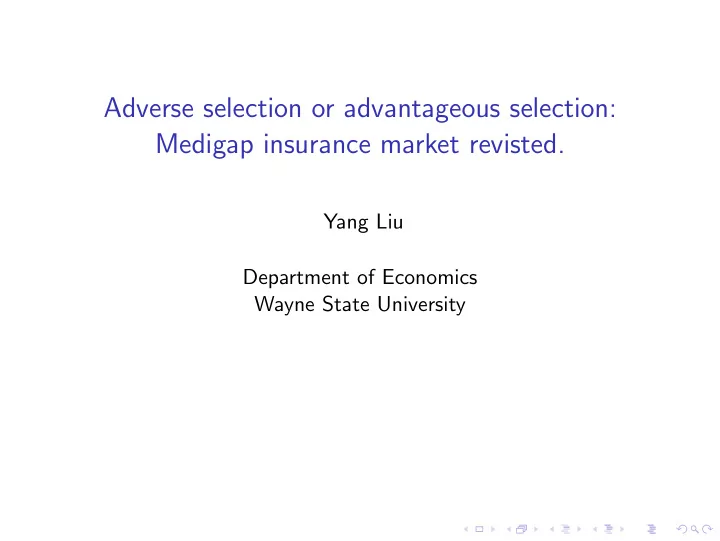

Adverse selection or advantageous selection: Medigap insurance market revisted. Yang Liu Department of Economics Wayne State University
Outline - Introduction - Literature Review - Open issues - Hypothesis test and Methodology
Introduction Asymmetric information in health insurance market. Rothschild and Stiglitz(1976) claim the information asymmetry lead to adverse selection based on the assumption that there is uni-dimensional information. They use only one parameter p to distinguish high risk type and low risk type. Insurer has no information on types of insured and charge same premium for both low type and high type. Insured knows their type; therefore, high type is more likely to buy insurance or buy more insurance than low type. Empirically, papers that investigate selection effect on the asymmetric information insurance market (not limited to health insurance market) questions on the positive correlation hypothesis and suspect the information in the insurance market is uni-dimensional.
Literature that investigate selection effect in insurance market Hemenway (1990) Health insurance and High risk tends rental car insurance to buy less coverage McCarthy and Life insurance Mortality rate is lower for those Mitchell(2003) who purchase whole-life insurance Cohen (2005) Auto insurance Those who choose low deductible and tend to have more accidents
Literature that focus on selection effect in the health insurance market Olivella and Private health insurance Adverse selection Vera-Hernandez (2012) market in UK Fang, Keane and Medigap insurance market Advantageous selection MacGarry (2006) Finkelstein and Long-term care No statistically significant MacGarry (2006) insurance market correlation between LTC and nursing home care usage Wolfe and Medigap insurance market Better self-reported respondents Goddeeris(1991) were more likely to purchase Medigap and they didnt spend more on health care
Open Issues The issue on the selection effect in the insurance market is far from settled. Why do we choose Medigap insurance market? 1. It is highly regulated insurance market. The premium is set in the basis of age, gender, residence and tobacco use (smoking). 2. Medigap insurance is optional to medicare beneficiaries. They could choose only basic medicare, medicare managed care or basic medicare plus medigap. Therefore medigap insurance market could more accurately measure who would like to buy more health insurance in order to get their loss covered
Hypothesis The hypothesis that we would like to test in the Medigap insurance market 1. Whether there is positive correlation between risk and insurance demand 2. The correlation could be positive, negative or zero. What is the meaning of the relationship? 3. If the information is multi-dimensional instead of one-dimensional, what are the potential sources that could affect selection. 4. How to disentangle incentive effect and selection effect.
Probit Model Setting Y ∗ Medigap = β 0 + β r X risk + β p X premium + ε where Medigap=1 if Y ∗ Medigap > 0 and X risk is hard to observe, therefore we could use either health care utilization or total health care expenditure as proxy; X premium are features used to set up insurance premium, e.g. age, gender, residence and smoking.
How could we disentangle selection effect from incentive effect? Coefficient of risk can be positive, negative or zero. Various possibilities: ◮ Positive: adverse selection plus moral hazard; or advantageous plus moral hazard (as long as the effect of advantageous selection is less than the effect of moral hazard) ◮ Negative: advantageous selection plus moral hazard (advantageous selection effect is greater than moral hazard effect) ◮ Zero: selection effect and moral hazard effect are cancelled out.
Note: According to previous literature, moral hazard can actually be divided into ex ante moral hazard and ex post moral hazard and they can be called together as incentive effect. Both of them are theoretically and empirical will have positive effect on the consumption of health care. Here, we just ignore the ex ante moral hazard and just call ex post moral hazard as moral hazard.
Then we start to add more potential sources into the basic model. Observable variables ( X other ) such as risk tolerance, income, education, cognitive ability can be added on to see how would this affect the coefficient in front of the health care utilization: Y ∗ Medigap = β 0 + β r X risk + β p X premium + β o X other + ε Data set used: MCBS and HRS
Alternative method: use total health expenditure to proxy the risk. In the case we need to impute data from MCBS to HRS. Then use linear regression after data imputation.
Thank you!
Recommend
More recommend